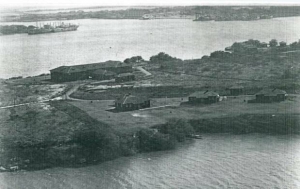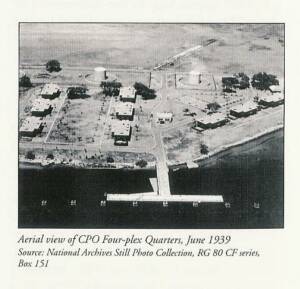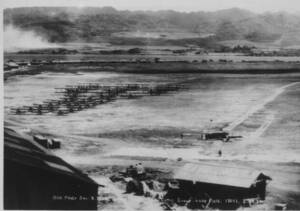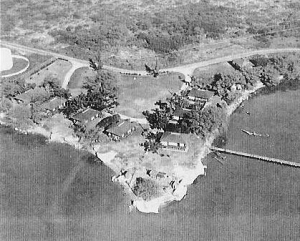1902: The US Navy purchases 25 acres of land on Ford Island and O‘ahu.
1917: Battery Adair is built by the Army on the northeast side of Ford Island.
1918: The Army erects two seaplane hangars, seaplane ramps, a warehouse, and a shop building. The Army air squadron transfers from Fort Kamehameha to Ford Island and a narrow strip of land was cleared to make room for an airplane runway.
1919: The first naval aviators arrive in Hawai‘i and establish a temporary base at Pearl Harbor Navy Yard. The Army installation on Ford Island was officially named Luke Field after WWI ace pilot Frank Luke.

Married Officers’ Quarters with BOQ in background, 1923. Source: National Archives Still Photo Collection, RG71CA, Box 192
1921–22: Ten homes and five duplexes are built by the Army, creating the Luke Field Neighborhood.
1922: The Navy begins construction on three married officers’ homes (Quarters A, B, C) on the north end of the island later known as “Nob Hill.” Quarters A was designated as the Commanding Officer’s Quarters.
1923: A large Bachelor Officers Quarters and servants quarters were built near the married officers’ quarters in the Nob Hill neighborhood. Servants quarters were also built across the street from two of the married officers’ quarters.
1923: Six one-story houses are built on Belleau Woods Loop for married Chief Petty Officers. These houses were physically separate from the Nob Hill homes, but were also northeast of the aviation facilities.
1932: The Navy has 39 aircraft on Ford Island, including seaplanes and land-based patrol squadrons.
1934: A magazine was built near the married officers’ quarters. 1935: Four additional seaplane ramps and “Seaplane beach” are built by the Navy on the south shore of Ford Island.
1936: Sixteen additional houses are built in the Nob Hill neighborhood with two different designs.
 1937: Nine fourplexes for Chief Petty Officers were built on landfill generated by dredging the nearby shore to build the battleship mooring quays.
1937: Nine fourplexes for Chief Petty Officers were built on landfill generated by dredging the nearby shore to build the battleship mooring quays.
1939: The Navy gains complete control of the island and as the emphasis shifts from seaplanes to aircraft based on ships, the Navy expands its facilities on Ford Island to repair and maintain aircraft carriers.
1939: Three additional CPO houses were built close to the four-plexes. These houses are known as facilities 68, 69, and 90.

Pearl Harbor Attack on December 7, 1941. This aerial view shows the Nob Hill neighborhood fronting “Battleship Row.” This photo was taken soon after USS Arizona was hit by bombs and her forward magazines exploded. Photographed from a Japanese aircraft. U.S. Naval History and Heritage Command Photograph.



